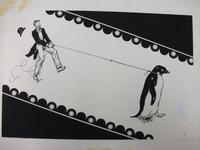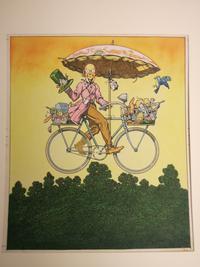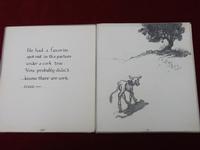We here at the Free Library of Philadelphia are thrilled to see the children’s book author and illustrator Robert Lawson (1892-1957) getting some press for upcoming film projects based on books he illustrated. I may be feeling proprietary, however, having just finished the processing and description of The Frederick R. Gardner Collection of Robert Lawson. Thanks to Gardner’s donation of this collection to the Free Library, and to a generous CLIR Hidden Collections grant that allowed us to process it, I’ve had the opportunity to learn a lot about Robert Lawson and his work.
Robert Lawson is primarily remembered as an illustrator but, as I discovered early in the project, he also was a very funny and engaging writer for both children and adults, and we’re lucky to have many of the speeches and articles he wrote. He was an early and impassioned defender of what he called “bad books for children,” and delighted in creating mischievous characters that occasionally frustrated the parents of his time. In a speech about Ben and Me (1939), the first children’s book he both wrote and illustrated, Robert Lawson talked about the difficulty of his doubled task:
"Ordinarily I get a manuscript from the publishers and illustrate it pretty much as I please, giving very little thought or attention to the author and his wishes. But in this case, I, the illustrator, had a great deal of fault to find with the story that I, the author, had given me to illustrate. And of course, as the author, I felt that the illustrator was not doing justice to my story at all. So that by the time it was finished we were both very mixed up and hardly on speaking terms. I do hope that the public or Little Brown and Company will decide whether I should get a better author for my illustrations or a better illustrator for my authorings or whether it would be simpler to just quietly drown both of us."
I spent more time than I care to admit chuckling quietly to myself in the manuscripts room, surrounded by his papers.
I was excited to process his papers, but the real gems were to be found in the thirty-six boxes of original illustrations and artwork. For our fellow archivists curious about extent, that’s about fifty-five linear feet; for the rest of our readers, that’s more than 1,200 items. While Lawson’s illustrations are still incredibly charming in today’s bookstore copies of The Story of Ferdinand (1936), it is difficult to truly understand the mastery he brought to illustration without seeing the original art. The bulk of his work is highly detailed pen and ink illustrations, but Lawson was equally adept with charcoal, graphite, colored pencil, and watercolor. Even before his career in children’s books Lawson had accumulated a dizzying range of artistic experiences: working as a camouflage artist in France in World War I (we have a pocket sketchbook he kept during his deployment); designing greeting cards with his wife and fellow-illustrator Marie (we have some of these, too); and winning the John Taylor Arms Prize from the Society of American Etchers.
There are forty-seven titles represented in the illustrations series, many of which were also written by Robert Lawson. My childhood love of penguins made it particularly thrilling to catalog the original artwork for Richard and Florence Atwater’s Mr. Popper’s Penguins (1938), and I found a new favorite in McWhinney’s Jaunt (1951). Another Lawson-authored story, in it we meet absent-minded inventor Professor Ambrose Augustus McWhinney the day he takes his trusty bicycle on an unusual trip; filling the tires with Z-Gas (his own creation of course), McWhinney finds himself bicycling through the sky. Of course, charming adventures are had. We also have the original dummy (a mockup of a book created by the artist to anticipate the appearance of the published work) for The Story of Ferdinand. The dummy is rightly described as a highlight of the collection, familiar and yet new: the illustrations are sketched in pencil; the story is handwritten (and hand-corrected, see right); and the title page was entirely redesigned for publication. If, like me, you grew up enamored of the gentle bull and his horticulturally unusual cork trees, it will be no surprise that this is the item I most hated putting back into its archivally-sound, acid-free housing. We hope you’ll come visit us and discover your own favorites.
- Caitlin Goodman
Have a question for Free Library staff? Please submit it to our Ask a Librarian page and receive a response within two business days.



